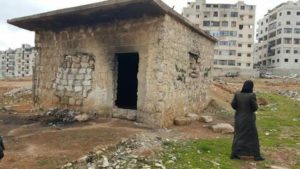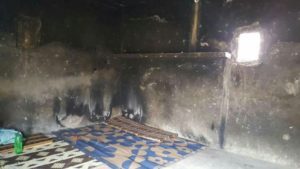Syria’s Next Aleppo? The War Crime of Forced Displacement
We are afraid that a massacre will happen because of the large number of forcibly displaced people in the [Idlib] area.
Mohammed Eysa, Idlib
“[T]he Aleppo evacuation agreement amounts to the war crime of forced displacement.”
– Report of UN’s Commission of Inquiry
The UN’s latest report calls the forced displacement of East Aleppo’s population, the majority of whom were forcibly transferred to Idlib, a war crime. East Aleppo is just the most prominent example of the Assad regime’s systematic strategy in which it besieges an area, bombs and starves it into submission, coerces a “settlement,” and transfers the population in whole or in part to Idlib. In Idlib, the conditions for civilians are worsening as the population grows, with internally displaced persons (IDPs) now making up over 50% of the governorate’s population. Many believe that the Syrian regime will ultimately conduct a full-fledged military onslaught against the people of Idlib under the pretext of attacking terrorist groups.
FORCED EVACUATIONS INTO IDLIB
The following are the approximate numbers of people transferred to Idlib in the last 6 months:
- February 20, 2017: 200 people from Serghaya (Source: Syria Direct)
- January 28, 2017: 2,059 people from Wadi Barada (Source: UNOCHA)
- December 15-22, 2016: 17,000 people from East Aleppo (Source: UNOCHA)
- December 2, 2016: 2,093 people from Al-Tal (Source: Siege Watch)
- November 28, 2016: 2,000-3,000 people from Khan al-Sheh (Source: Syria Direct)
- October 17, 2016: 3,000 people from Moadamiya (Source: Siege Watch)
- October 13, 2016: 1,000-2,000 people from Al-Hameh and Qudsaya (Source: Siege Watch)
- August 26, 2016: 8,300 people displaced from Daraya, majority to Idlib (Source: Siege Watch)
CONDITIONS FOR IDPS
“We are afraid that a massacre will happen because of the large number of forcibly displaced people in the area. [IDPs] are suffering in hard living situations, even struggling to find a house to live in.” – Mohammed Eysa, relief worker in Idlib
“One of the hardest moments for me during my recent work with IDPs was a regime air attack on Idlib. There was a 7 month pregnant woman, who died with her baby. The bombing and bursting pressure ripped open her belly and the unborn baby was blow out. They both died. When I saw this… I will never be able forget it.” – Badee Abras, medic in Idlib
The situation for IDPs in Idlib gets progressively worse with new arrivals, with supplies and shelter unavailable, and ongoing aerial attacks. There are more than 75 IDP camps* in Idlib and the Aleppo countryside. Particularly in the cold, mountainous areas, IDPs lack basic living supplies, especially fuel and means for heating. Families have no choice but to live in:
-
Cheap houses near a bombing zone. The cost depends on its proximity to areas facing frequent bombing: houses can range from $50 USD per month for a house close to areas frequently bombed, to $100-200 USD per month for a house near the Turkish border, further from bombing.*
-
Freezing tents. Buying a tent (wedge and fabric only) costs around $77 USD.*
-
Sleeping in the streets. For those who cannot afford to rent or buy shelter, they share housing with friends or relatives, share a tent with others, or sleep in the streets.*

Example of house outside of Idlib City for recently displaced family

One room house of a recently displaced family living in Idlib
*Statistics and information compiled from TSC interviews with humanitarian volunteers and media activists in Idlib.
To speak to any of the people interviewed for this research, please contact Kathleen Fallon: kathleen@thesyriacampaign.org +1 978-505-8231.
The Syria Campaign is an independent advocacy group campaigning for the protection of civilians. Find out more at www.TheSyriaCampaign.org